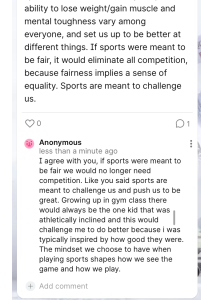2
Section One: The Fundamentals
A) History and Context
Exercise 1: Notebook Prompt
| Something that really surprised me was learning that women athletes take drugs when their testosterone levels are naturally higher to lower their testosterone levels. This is due to differences of sex development policies which restrict female atheletes from competing in certain sports if their testosterone levels are high, it forces female athletes to either not compete or medically change their hormonal makeup. It was quite inspiring that the Kenyan athlete took this case to court and challenged the DSD policy. She argued that these policies are discriminatory which I agree, it’s not fair to force athlete’s to change their biological Makeup to compete in sports, it’s not something that can or should be controlled.
|
B) Timeline of History
Exercise 2: Notebook Prompt
What other significant case/milestone would you add to this timeline? Note it in your notebook along with a brief (one or two sentences) explanation of why you feel it is important.
|
A significant milestone that I would add to this timeline would be in 1976, when Renee Richard’s who is a transgender woman was banned from the U.S women’s division because of the Barr body testing that was introduced to verify sex. Renee challenged this in court and won, which allowed her to compete in 1977. This case resulted in legal debates about gender inclusion policies, and this is why I believe it should be apart of the timeline. This case was inspiring to me because I believe that there needs to be more gender inclusion, and in 1977 society was not as inclusive or progressive as we are now. So seeing Renee standing up for what she believes is right is so amazing. https://www.si.com/tennis/renee-richards-shares-the-gender-policy-recommendation-she-made-to-the-wta https://wearetennis.bnpparibas/en/news-tennis/stories-commitment/6276-1977-richards-from-man-to-woman#:~:text=Ren%C3%A9e%2520Richards%2520did%2520not%2520enter,changed%2520sex%2520a%2520year%2520before. |
C) Gender coding in Sports
Exercise 3: Notebook Prompt
Has the gendering of sport ever been a constraint on your involvement? How?
Or, if not, why do you think this is?
| I would say that it has not. I play lacrosse and often lacrosse is viewed as a male sport. and It has never stopped me from playing. I have always enjoyed my time playing both field and box lacrosse. One thing that I’ve noticed that’s been quite an interesting observation is that the rules in male and female lacrosse is extremely different. Often women are at a disadvantage in the sport because their sticks have more shallow netting becasue the sport is less contact heavy in woman’s lacrosse. Which I disagree with, women’s lacrosse is still very aggressive. Men’s lacrosse is full contact and they have deeper stick pockets. I believe that men have a slight advantage in lacrosse with their sticks, and particular rules in the game. But overall the gendering of lacrosse has not stooped me from playing. i also believe that sports are for anyone and anyone who has the passion to play should be allowed. The gendering of a sport has not stopped me from playing because in my mind we are all equal and should all have an equal chance to play, to learn and to grow in sports. Societal perspectives and narratives should not deter anyone from playing a sport. |
D) How is sport gendered in the popular imagination?
Exercise 4: Padlet/Notebook Prompt
While most sports are in fact unisex, gender coding remains pervasive, particularly at the professional level, although with a foundation established in youth competition. Participate in the poll below to share your views on how popular sports are gendered in the popular imagination. Also feel welcome to add or suggest sports that you feel strongly conform to the gender binary!
After you contribute to the padlet prompt, record your response in your notebook AND briefly discuss in two or three sentences how these responses and the polling figures in general confirm or contradict your assumptions about gender-coding and sports. Did anything surprise you?
| I put up the swimming poll.
After evaluating the polls most of my assumptions aligned with what other people assumed. One that surprised me was powerlifting. the pole voted mainly voted for men, although I feel that as we have been seeing more and more in the gym, we see a lot more women powerlifting. As social media continues to promote a gym life style, both genders have adopted powerlifting a lot more recently than before. Cheer leading has continued to be a female sport with males as a base for as long as I can remember. The reason for this is mainly the clothing and the nature of the sport, it requires more flexibility and being a base requires a bit more strength. While I make these assumptions I do recognize that men are and can be flexible and I recognize that females are strong and can catch people as a base.
|
Section Two: Breaking it down
A) Title IX
Exercise 5: Notebook Prompt
In a longer version of the interview excerpted in the video above, Leah Thomas states “Trans women competing in women’s sports does not threaten women’s sports as a whole because trans women are a very small minority of all athletes and the NCAA rules around trans women competing in women’s sports have been around for 10+ years and we haven’t seen any massive wave of trans women dominating”?
Do you agree with this statement? See also the image above suggesting that the issue may be overblown by politicians and influencers who don’t actually care that much about women’s sports.
Please share any thoughts you have in your Notebook by clicking on the audio button above or writing a few sentences.
|
Leah Thomas argues that trans women competing in women’s sports do not pose a threat to women’s sports as a whole because of the small percentage of athletes that are trans. I agree slightly because data does not support that trans women are taking over women’s sports. I believe that there is no issue with trans women competing in women’s sports because they are WOMEN. there are greater issues in women’s sports such as a lack of funding and media coverage. The debate around trans women in women’s sports is a result of trying to challenge and control trans women rather than true fairness which is the claim. There is little advocacy for women’s sports and because a trans woman is competing there was a significant amount of media coverage on the topic itself and trying to “ advocate” for women’s sports. Truly i see no issue except an issue that society must overcome, we need to break through these barriers and advocate for ALL WOMEN in womens sports to have more funding and greater media coverage with equal chances.
|
B) Unfair Advantage?
Exercise 6: Notebook Prompt
What does the host and writer, Rose Eveleth, have to say on the issue of unfair advantage?
Can you think of other examples of unique biological or circumstantial advantages from which athletes have benefitted enormously that have nothing to do with gender?
|
An example that is beyond gender related factors are athletes that benifit from genetic traits or specific training in particular environments that enhance their performance. As mentioned in the module Micheal Phelps has genetic factors such as not producing as much lactic acids and an abnormally long wingspan which aids in his ability to swim. A factor that is beyond gender is training, an example is high altitude training that is done by long distance runners in Kenya and Ethiopia. Training in these environments enhances their bodies ability to use oxygen efficiently which aids in their endurance, providing a natural advantage in long distance running. https://www.sciencedirect.com/science/article/abs/pii/S1095643303002277#:~:text=Kenyan%20elite%20runners%2C%20however%2C%20appear,compared%20to%20their%20Caucasian%20counterparts. |
Again, let’s turn to Katie Barnes who points out that we tend to forget amidst all the debate that “sports, by design, are not fair” (235), that “the reality of sports is that we accept unfairness all the time” (235).
Do you agree? Why? In your experience, how fair are sports? Feel welcome to add a video response in the padlet and provide an example if you’re willing. Make sure you include a screenshot of your response in your notebook.
|
The padlet I posted My response to someone
|
B) The Paris Olympics
Optional Response:
What does Robins mean when she argues that:
“The aims of transvestigating an Olympic athlete are not, in any meaningful sense, anything to do with sports, or fairness, or even with women (cis women, at least) as a social category. Rather, they have everything to do with transness, and the public expression of transfemininity.
For my money this has never been about sport.
What it has always been is an excuse to publicly relitigate the existence of trans women.”
Make a note in your Notebook.
|
What I believe Robins argues in that quote is that punishing or outcasting the gender identity of Olympic athletes about fairness is not coming from a genuine place or concern or equality or ensuring that women’s categories are protected. It’s more about asserting policies about trans individuals and targeting trans female individuals especially in sports and in public. I think Robins is trying to say that it is not coming from a place of genuine concern but rather to outcast and challenge trans individuals, its undermining them and questioning their legitimacy of a trans women.
|



